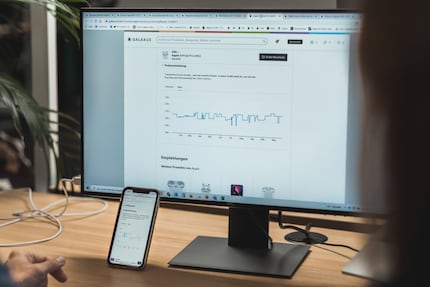
Behind the scenes
How dynamic pricing at Galaxus works
by Manuel Wenk

Transparency fosters trust, shows a joint study by the University of Zurich and Digitec Galaxus. We asked Andrea Giuffredi-Kähr from the University of Zurich and Tobias Quelle, our Head of Product & UX, why researchers are so interested in online retail – and what’s in it for customers.
Andrea, you’re a business economist and Assistant Professor in Marketing in the Digital Economy. Why are you interested in the buying behaviour of online shoppers in particular?
Andrea: Online shopping has developed rapidly, especially in the last two years of the pandemic, and is becoming increasingly important. The industry is booming. According to a study conducted by Handelsverband.swiss (Swiss trade association) together with the market research institute GfK and Swiss Post, Swiss consumers purchased 13.1 billion Swiss francs’ worth of goods online in 2020. That’s an increase of 2.8 billion Swiss francs, or 27.2 per cent, compared with the previous year. So, it’s no surprise that both we and our partners agree online retail is a field of research that needs to be analysed.
What research questions did you focus on?
Andrea: We were particularly interested in two aspects. When shopping online, it’s easy for customers to find all the product and price information they need in just a few clicks – for example, by consulting price comparison sites or competitors. When shopping at the point of sale, i.e. in a brick-and-mortar store, information is limited. First of all, we’re interested in how this extra information influences users’ buying behaviour; and second, what factors influence their shopping experience and/or relationship with the brand. The fact that we can easily and in detail follow customers’ entire purchasing process is unique to online retailing and incredibly useful. Offline behavioural analyses are much more complex. In most cases, customer groups have to be canvassed in market studies. These are expensive and time-consuming.

So, do online shoppers really use the available information on the net? Or do they behave irrationally and make spontaneous purchases?
Andrea: It depends. In research, we speak of involvement. That is, the personal importance of or interest in a given product. If you just need a new toothbrush, you probably won’t go on a time-consuming Internet search to find the best model for the best possible price. Larger investments, like a food processor, are another story. In this case, you’re likely to gather all the necessary information before making the purchase. If we look at the typical customer journey – that is, the process from first contact to purchase – we see that search behaviour has changed significantly. The reason: for many customers, access to information is no longer a hurdle.
Tobias: You carried out this study in collaboration with the business economists at the University of Zurich. What did you hope to get out of the collaboration?
Tobias: Working with renowned researchers who are experts on the subject of price development and purchasing behaviour is very interesting for us. Not to mention, the cooperation between business and science is profitable for all those involved.
A win-win situation?
Tobias: Exactly. Especially in the case of an emotional topic such as price, it can be helpful to have an external evaluator on board. This evaluator closely assesses our survey results and evaluates them independently – as was done with the A/B testing of our price transparency feature. We’re happy to say our results were congruous.
Why did you choose the University of Zurich and not the University of Bern or the University of Basel?
Tobias: We looked at the current state of research before making our decision. In doing so, we noticed that the University of Zurich has plenty of expertise in the research of «price effect». In fact, they had published a study in 2011 whose results contradicted our hypothesis. Said study concluded that price transparency leads to purchase restraint. So, I approached the university and got them on board to provide scientific support for our testing.
How satisfied are you with the results?
Tobias: Very much so, because it turned out our hypothesis was on point. Our price transparency tool generates added value for our customers. Specifically, it fulfils the need for information. The accompanying survey also revealed that the new feature made for transparency and trust – which was precisely our goal. We can also use this feature to establish our subsidiaries in Germany and Austria. This is because it shows new customers that Galaxus stands out from the competition in terms of transparency and fairness.

And what about the users north of the Rhine, where price sensitivity is at least perceived to be higher than in Switzerland?
**Andrea: ** Contrary to expectations, we didn’t find any country-specific differences in purchasing behaviour – with the exception of brand perception. In Germany, we actually discovered that the introduction of the price transparency feature has strengthened loyalty to the Galaxus brand.
Tobias: The results have indeed been very encouraging. In particular, the fact that we could see the same positive effects on all portals. That’s why we immediately rolled out the price transparency tool in Germany and Austria. Honesty is a brand attribute we want to actively demonstrate.
What methods did you use in the study?
Andrea: In research, we often conduct experiments under laboratory conditions. Of course, this allows us to measure only hypothetical behaviour. Not so in this research project, which made it all the more interesting for us. In this study, we were able to investigate how Galaxus customers have been behaving since the introduction of the price transparency tool – in real life. In addition, we conducted a qualitative survey to learn more about how easy the price charts are to read as well as the resulting perception of the brand.
Tobias: In the development of our online stores, we work in iterations according to the motto «build – measure – learn». In the initial A/B testing, we still had the price transparency tool collapsed by default to see how shoppers were using it. However, we quickly realised that the price charts weren’t getting the attention we had hoped for. So, we launched a second test in which we made the price chart more prominent. The results clearly showed that the feature was indeed much more visible this way. It was used more and, as a result, built more trust. Based on the positive results, we rolled out the feature to all portals on 13 September 2021.
What does this feature mean for our customers in concrete terms?
Tobias: Our Community benefits from the additional information on prices. You can see the history of all sales prices underneath each product. Almost half of all users consult the price transparency tool, so it really is actively used. The tool allows customers to decide on the basis of price trends whether they want to buy a given product today, tomorrow or not at all. In our eyes, «No, thanks» is a perfectly legitimate answer. We want online shoppers to make a conscious decision based on how attractive a price is for them at any given time.

And what can we learn from the research?
Andrea: As mentioned, the methodology we used shows us users’ actual behaviour. In combination with the subsequent qualitative survey, the results are incredibly useful. We were also able to get direct insight into questions that concern retailers such as Digitec Galaxus. It’s in everyone’s interest that researchers deal with relevant, present-day topics.
Any plans for future cooperation on this topic?
Tobias: We’ll certainly continue further work on the transparency feature together. But we do also have several other exciting projects in the pipeline. In terms of the price transparency feature, we've been working on extending the price history view. This makes us even more transparent by displaying more data. Of course, we still want to keep things mobile-device-friendly, so we’ve added an additional tab that provides more details for anyone interested.
Thank you very much for the interview.
Making sure employees and media know what's up at Digitec Galaxus is my job. But without fresh air and a lot of exercise, I basically stop functioning. The great outdoors provides me with the energy I need to stay on the ball. Jazz gives me the tranquility to tame my kids.
News about features in our shop, information from marketing and logistics, and much more.
Show all